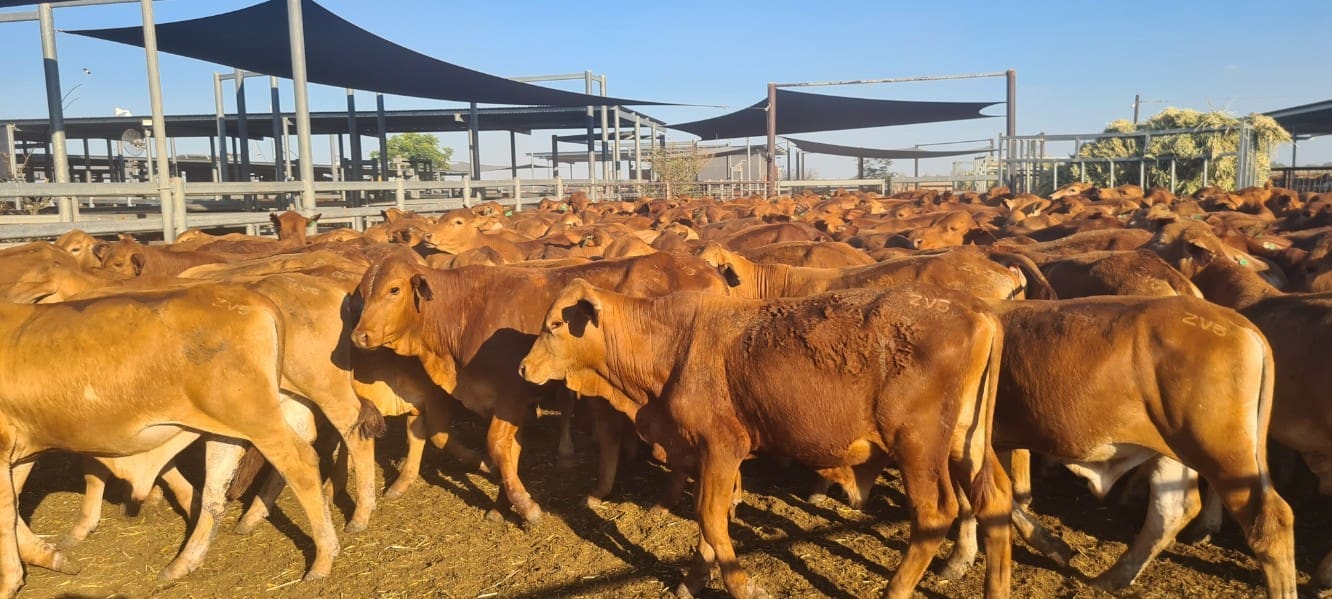
Part of a run of 1600 Droughtmaster backgrounder steers off Fossil Downs Fitzroy Crossing in the Kimberley, mostly 10-13 months sold in seven mobs averaging from 266kg down to 166kg made from 757c/kg ($1700) at the heavier end down to 892c/kg ($1410) for a lightweight line of 250 head averaging 166kg.
A CLEVER strategy to ‘take the hard work out’ of accessing quality cattle from the remote Kimberley region for buyers in southern and eastern Australia has paid big dividends for Hancock Agriculture’s Fossil Downs station near Fitzroy Crossing.
Fossil Downs offered about 1820 quality young Droughtmaster steers and heifers on AuctionsPlus on Friday, selling to extraordinary rates previously unseen for Kimberley-bred cattle. It was one of the larger single sale offerings for any vendor seen on the online marketing platform this year.
Key to the project was a decision by the vendors, working with marketing agent Todd Walsh from Northern Rural Supplies in Broome, to offer the eight lots delivered to Roma in southern Queensland (or equivalent) – a transport distance of some 3369km, according to Google – instead of the traditional terms of being sold ex property of origin.
Dipping to clear the cattle from ticky to clean country, and several nights’ spelling were included in the vendor’s terms – clearly designed to motivate eastern Australian restocker buyers to operate. The total cost involved (transport, spelling, dipping) worked out at ‘roughly’ 100c/kg – a lot of money, but well justified, given the reception the steers and heifers received in the marketplace. Some of the lighter lines will be quite efficient to transport, loading at about 42/deck.
The 1600-odd quality Droughtmaster backgrounder steers, sold on seven mobs each of six decks, were mostly 10-13 months drafted into mobs averaging from 266kg down to 166kg. They made from 757c/kg ($1700) at the heavier end down to an unbelievable 892c/kg ($1410) for a lightweight line of 250 head averaging 166kg. Most of the reserves on the steers were in the 650-700c range, freight included.
A single line offering of their older heifer sisters – 216 Droughtmasters 18-24 months averaging 248kg – were offered under similar delivery terms. They made $1700 or 684.4c/kg when secured by an eastern states buyer, selling about $300 a head above the reserve.
Even deducting a figure of around 100c/kg off the sale price for the freight exercise, and these Fossil Downs steers and heifers easily set all-time records for young cattle sold out of the Kimberley region.
Similar Fossil Downs steers, 12 months older averaging 300-330kg, have sold into the live export boat trade earlier this year for 400-415c/kg or around $1200-$1300.
Buyers for Friday’s offering came from five separate states, with consignments heading to Queensland, NSW, Victoria, South Australia and southern parts of Western Australia. Most went back to the paddock for backgrounding.
“We were just trying to take the considerable logistics hassle out of buying the cattle on property for an eastern or southern states buyer,” Mr Walsh told Beef Central this morning.
Fossil Downs carried out a similar strategy last year, selling large runs of young steers also delivered Roma. Prices were typically around 130-150c/kg below those achieved on Friday, but the market has moved a long way since then.
Another of the keys behind the sale was the quality of the genetics on offer.
“We’re lucky to be able to deal with these Fossil Downs Droughtmaster steers, that definitely command respect in the marketplace,” Mr Walsh said. “This exercise would not necessarily work the same, in terms of buyer response, if the quality of the cattle was not present. You’ve got to put the right article up, that southern buyers are prepared to have a go at,” he said.
Fossil Downs has built up a Droughtmaster herd regarded as one of the best in the Kimberley, using premium herd bulls from some of Australia’s best credentialed Droughtmaster seedstock herds including Glenlands, Clonlara, SC, Valera Vale, Sevenell/Lyndsay Park, Rodlyn, Piggots, Munda Reds, High Country, Mostyndale and Aldinga.
The Fossil Downs herd underwent a remarkable transformation from its original Kimberly Shorthorn base over many years, under the management of original owners John and Annette Henwood.
Examples like this, with vendors and their marketing agents thinking outside the square, are being heavily influenced by the extraordinary young cattle market cycle that Australia is currently experiencing. The Eastern Young Cattle Indicator re-set its record high again on 26 October, reaching 1076c/kg, up around 250c/kg on this time last year.

Jon it is fantastic to read of this sale. In the early days of the development of CALM the Kimberley was identified as a major cattle breeding region that had only minimal access to Australia’s cattle market.
The involvement of CALM in the B-Tec eradication process in the late 1980’s exposed electronic marketing for the first time in the Kimberleys. The owners of several stations including Anna Plains, Go Go, Mt Barnett and Fossil Downs commenced using the system and benefited from the wider market demand, particularly from live cattle exporters.
As you have headlined, this sale reflects ” smart strategy” on the Rinehart management of “Fossil Downs”. No doubt others will follow this tactic.
So if somebody purchased these cattle from closer than Roma, does that mean they get a freight equivalence in discount to the price. If not, it could be argued that the delivery is discriminatory to local buyers.
Thanks for your comment, Bill. Not sure what the answer is, but we can ask the connections what would happen in that event, and add it to this comment. But a point to ponder – couldn’t the same be said for a vendor from Cloncurry selling cattle at a Roma store sale – isn’t that ‘discriminatory’ against buyers from other areas? It makes plenty of marketing sense to take the cattle to where the buyer audience is, in our opinion. Editor